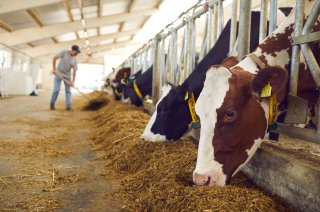
category_news
Tests yield first successful methane sensor
In order to measure the relatively low methane concentrations in naturally ventilated dairy houses, high requirements are placed on the measuring equipment. Until recently, no acceptably priced sensor was available to accurately measure these low concentrations. A process of inventorying, testing and validation conducted by Wageningen Livestock Research has yielded the first sensor that meets these requirements.
Towards emission-targeted management
An accurate sensor can measure the methane concentration in dairy barns, contributing to continuously monitor methane emissions from the animal house as part of a future where management on emission goals rather than emission measures can be implemented. Such a future calls for measuring systems that provide farmers with insight into the amount of methane they emit. This insight enables them to focus on their compliance and on lowering emissions.
Inventorying and selecting suitable sensors
A preliminary investigation showed there are plenty of sensors on the market, but most are designed to detect the lower explosive limit of methane which is at high concentrations . The concentrations of methane in dairy barns, however, are between 1000 to 10,000 times lower than the lowest explosion limit. Hence, Wageningen Livestock Research began by formulating what requirements a methane sensor must meet to be effectively deployed in dairy houses. The most important criteria were the measuring range, accuracy and price. Next, various businesses were asked whether they were able to either deliver or develop a methane sensor that meets these criteria. The ABB methane sensor (EL3020 with a Uras26 measuring cell) and the Axetris (LGD Compact-A) met the demands and were then tested in laboratory and field.
Tests and validation readings
The selected methane sensors were extensively tested in the laboratory, after which they were tested in open-air field conditions. The results were compared to golden standard measurements. Both the ABB and the Axetris performed well. Due to its lower price and its robustness under field conditions, the Axetris sensor was selected for a validation trajectory in accordance with the development and validation protocol. Four Axetris sensors were deployed in four different dairy houses for a full year, during which eight golden standard measurements were taken per sensor. This showed that the Axetris LGD Compact-A is, indeed, suited to measure methane concentrations between 0 and 100 ppm accurately in dairy houses.
Next steps
This is a step forward in the direction of a new measuring system. Some questions remain however. For example, it is important to measure not only the concentration inside the dairy house but also the concentration of air entering the house from outside. At this time, there is no saying whether the sensor is suited for this purpose. For continuous emission measurements in naturally ventilated (dairy) houses, a reliable sensor for carbon dioxide (CO2) concentrations in houses and outside air is also needed. The range of sensors available for this purpose is extensive, so this is not expected to be an issue. Finally, the researchers recommend following the results yielded by the Axetris LGD Compact-A over the coming years. The trustworthiness of the sensor under prolonged use can be assessed using reference readings.